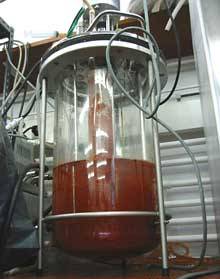Anammox

Anammox, an acronym for anaerobic ammonium oxidation, is a stage in the nitrogen cycle. In this biological process, nitrite and ammonium are converted directly into dinitrogen gas. This process contributes up to 50% of the dinitrogen gas produced in the oceans. It is thus a major sink for fixed nitrogen and so limits oceanic primary productivity. The overall catabolic reaction is:
NH4+ + NO2- → N2 + 2H2O.
The bacteria that perform the anammox process belong to the bacterial phylum planctomycetes, of which Planctomyces and Pirellula are the best known genera. Currently four genera of anammox bacteria have been (provisionally) defined: Brocadia, Kuenenia, Anammoxoglobus (all fresh water species), and Scalindua (marine species). The anammox bacteria are characterized by several striking properties: they all possess one anammoxosome, a membrane bound compartment inside the cytoplasm which is the locus of anammox catabolism. Further, the membranes of these bacteria mainly consist of ladderane lipids so far unique in biology. Of special interest is the turnover of hydrazine (normally used as a high-energy rocket fuel, and poisonous to most living organisms) as an intermediate. A final striking feature of the organism is the extremely slow growth rate. The doubling time is nearly two weeks.
The application of the anammox process lies in the removal of nitrogen in wastewater treatment. Instead of the conventional nitrification-denitrification process, only half of the nitrogen has to be oxidized partly to nitrite. For the enrichment of the anammox organisms a biofilm system seems to be especially suited in which the necessary sludge age of more than 20 days can be ensured. Other possibilities are sequencing batch reactors (SBR) or gas-lift-loop reactors using granular sludge. The cost reduction compared to conventional nitrogen removal is considerable; the technique, however, is still young. The first full scale sludge-water treatment plant using the biological process of anammox was built 2000 in Germany (Hattingen). As of 2006 there are three full scale processes in The Netherlands. One on a municipal wastewater treatment plant (in Rotterdam), one on an industrial treatment plant (tannery) and one full scale application using SBR at the wastewater treatment plant Strass, Austria.
References
- www.anammox.com
- citeUlike for an up to date overview of relevant scientific literature.
